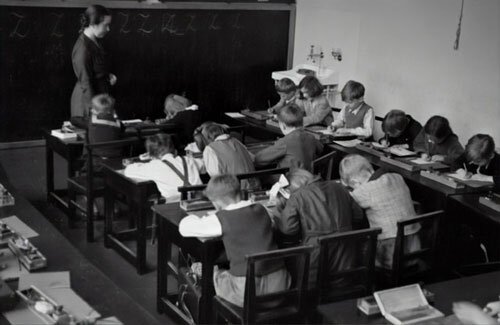Why Choose Adventist Education?
Looking for an excellent option for your education?
Do you want an education system where you will receive a tailored learning experience in a family atmosphere—an atmosphere nurtured by teachers who are intentional about students’ character development?
Then an Adventist school is your best pick!
At Adventist learning institutions, school means much more than academic success. It means growth of the student as a whole person.
If you are the student, your experience at Adventist learning centers will be made even more meaningful by opportunities to engage in useful service to the community.
And there’ll be a perk to the whole experience.
After you’re done with school, you’ll get to take with you lifetime friendships made with wonderful staff members and fellow students. Friendships that will last for eternity.
Sounds interesting to you?
Let’s then, take a closer look at the Adventist educational system—its history, its philosophy, and more reasons why it’s an excellent option!
How did the Adventist Education System Begin?
 In 1868, Goodloe Harper Bell started a private school for Adventist children. This was a locally supported school in Battle Creek, Michigan.
In 1868, Goodloe Harper Bell started a private school for Adventist children. This was a locally supported school in Battle Creek, Michigan.
And among his first students were the sons of James White and Ellen White, some of the most influential founders of the young Seventh-day Adventist denomination then.
At the same time, the Adventist Church was beginning to grasp its worldwide mission. And to accomplish this mission, it needed missionaries to be trained, and sent out to evangelize the world.
And that’s where Adventist education came in.
In 1872, James and Ellen White encouraged Bell to help establish his 12 student school as the first Adventist owned school. It was upgraded into a missionary training institution and then called Battle Creek College.
Ellen wrote a comprehensive essay about the school titled “Proper Education,” which was published in the Health Reformer, a magazine published by the Adventist church.
In it, she described how this college, and others that would be established in future should be run. The principles she described in that essay became the backbone of the philosophy of Adventist education.
And based on that philosophy, many other schools were established. Starting in the United States—and into the vast mission fields of the world—Adventist schools were built wherever a church was planted.
And each school was adapted for the various needs and cultures of the communities they were designed to minister to.
But one thing remained constant for all of them—their mission.
The mission of all these colleges was to provide practical training to students in the distinct Adventist message. The trainees would then venture out as denominational or self-supporting missionaries.
And this mission was clearly evident, even in their earlier names. For example:
- Battle Creek College was renamed Emmanuel Missionary College. It has since grown into today’s Andrews University and Theological Seminary in Michigan, USA.
- College of Medical Evangelists, today’s Loma Linda University in California, USA.
- Southern Missionary College, today’s Southern Adventist University in Tennessee, USA.
- Australasian Missionary College, today’s Avondale College in Australia.
- Oakwood Industrial School, today’s Oakwood University in Alabama, USA.
- Solusi Mission, today’s Solusi University in Africa.
The purpose of Adventist education has always been to train young people for service. Service in the mission field, both at home and abroad.
And as these schools grew in numbers and patronage, they established institutions in all levels of learning.
If you do a quick search now, you’ll discover many Adventist institutions ranging from kindergarten, grade school, colleges, universities and all the way to graduate schools.
The Philosophy of Adventist Education
Ellen White’s essay, “Proper Education,” covered the Adventist education philosophy.
Here’s an outline of what it entailed:
- Education in the Context of the Plan of Redemption
- Redemptive Discipline
- Emphasis on Practical Manual Training
- Development of Students’ Individuality and God-given Faculties
Let’s take a look at each of these.
1. Education in the context of the plan of redemption.
 In this context, the whole person is developed—the physical, intellectual, social, emotional, and spiritual aspects of a student—as a means to restore the image of God in man.
In this context, the whole person is developed—the physical, intellectual, social, emotional, and spiritual aspects of a student—as a means to restore the image of God in man.
The education is therefore strongly evangelistic.
This means that beyond the book work, the whole process will seek to infuse biblical principles in all areas of student life.
And here’s what that means for you:
- Practical Healthy Living
- Strong Intellectual Culture
- Healthy Social Interactions
- Emotional Well-being
But top in its priorities is an intentional dedication to spiritual and character development.
And this is where teachers play a key role.
Teachers are wonderful role models, instructors, and mentors in the following ways:
First, through their example and influence.
In the daily interactions, you can’t help but notice their devotion to God and His service. You’ll also get to experience their love as they patiently instruct you. And you’ll feel their friendship and concern for your personal and spiritual journey.
With all these, it’s only natural that you may be influenced to love both God and man.
As Lucien, a student at Oakwood University puts it,
“Whether it’s basketball, or health principles, or Revelation, they focus on academics as well as spirituality. This has made me comfortable to share with my professors beyond homework, to what I’m going through.”
Second, through classroom instruction based on the Bible.
Teachers make the Bible the basis of all instruction you’ll receive in class. Its principles are infused into the whole curriculum.
This was Tori Allen’s experience as a Communications Major at Oakwood University. She says,
“Learning the principles of public speaking with Paul as an example was so meaningful to me.”
Third, through the religious activities that are part of the daily schedule and school calendar.
 You’ll have prayer, Scripture readings, and worship as part of the daily school routine.
You’ll have prayer, Scripture readings, and worship as part of the daily school routine.
And every week, all staff and students have Sabbath off. They attend Friday evening services, Sabbath worship at local churches, and enjoy quality time with God, family, and friends.
Also, different Adventist institutions always host different spiritually enriching events, sprinkled throughout the school year. So, you’ll have many occasions to attend:
- Weeks of Prayer
- Quarterly Convocations
- And Music Concerts
Fourth, through community outreach and mission activities that inspire a spirit of loving service to God and man.
Adventist school curriculums always include community outreach programs as part of their graduation requirements.
So, at one point or another, you’ll experience the joy that comes with serving others in one or several of the following ways:
- Conducting healthy cooking schools
- Conducting evangelistic seminars
- Giving concerts with the school choir and/or orchestra
- Visiting nursing homes
- Mowing elderly or sick neighbors’ backyards or offering any practical help needed
- Giving Bible studies to interested members of the community
- Passing out evangelistic literature in the neighborhood
- Praying with those in need when you visit them in their homes
- Conducting surveys to identify felt needs in various communities and finding ways to meet them
And if you go to a boarding school and stay on campus, you’ll also get to help out in the church where you’ll attend in activities such as:
- Leading out in song service or playing instruments
- Teaching Sabbath school
- Helping with children and youth programs
- Helping organize Bible studies and prayer meetings
- Or even preaching at different services
At some schools, students and teachers come together and open their doors to host community events. If this is the case with the Adventist school you choose, you’ll experience the thrill of putting together large events like:
- Thanksgiving luncheons
- Christmas concerts
- Health expos
- Free clinics
- And even summer camps
A good example of a service activity is from Waldwick Adventist Academy in New Jersey, which hosts a yearly Pi Marathon. In this event, participants run or walk a 3.14 mile distance. They get to involve community members and leaders. Even the local mayor joins them for the events of the day.
 And still, some other schools organize mission trips to other parts of their countries, regions, or even overseas.
And still, some other schools organize mission trips to other parts of their countries, regions, or even overseas.
Going on these trips will expose you to different cultures and ways of thinking. You’ll learn to minister to various needs and present the gospel in a different culture from your own.
In fact, Adventist colleges and universities allow students to take gap years to go as student missionaries overseas before joining/during their time at college.
That can be a great way to spice up your college experience.
You can work with organizations like Adventist Frontier Missions or Adventist Volunteer Services, which coordinate and facilitate student missions ventures.
Ask anyone who tried it, and they’ll tell you it was life changing!
Because of all these, Adventist schools tend to become centers of influence within their communities and abroad. They make for real impact among those whom they are found, and in the world as a whole.
As Ed Sutherland, a leading pioneer of Adventist education said, “Real education must be the education of the whole community”(Sutherland, 2015).
And as a student at an Adventist institution of learning, you get to be part of that!
2. Redemptive Discipline
 This is where disciplinary measures are meant to show the students their mistakes, show them there is a better way, and inspire positive change.
This is where disciplinary measures are meant to show the students their mistakes, show them there is a better way, and inspire positive change.
So, in case you get on the wrong side of the school rules as it may happen, teachers will have a candid talk with you, and they will try to put your mistakes in true light. They’ll show you that more than being violations of school regulations, mistakes and rebellious acts violate God’s laws of love.
You’ll therefore be brought to repent of the mistakes mainly because you’ve seen how it hurts God, others, and sabotages your own success and happiness.
This approach is based on Jesus’ instruction on church discipline:
“If your brother sins against you, go and tell him his fault, between you and him alone. If he listens to you, you have gained your brother” (Matthew 18:15).
And in her book Education, Ellen White, sums it up by saying,
“Let the child and the youth be taught that every mistake, every fault, every difficulty, conquered, becomes a stepping stone to better and higher things”(White, Education, p. 277:4).
Adventists also believe education begins at home by the parents.
Home is where the basic values of redemptive discipline are first taught to children.
Then at school, children learn to apply those principles as they work with other pupils, adult members of the church, and the society in general.
And parents love it!
Caroline Hamilton, a parent at an Adventist academy affirms this arrangement when she says,
“I feel like the teachers are partnering with us in continuing the same values, and the same ideas, teaching from the Bible, just like we do at home.”
This kind of investment in an all round development of the student resonates with Ellen White’s statement:
“The work of education and that of redemption is essentially one.” (White, Education, p.30.2)
3. Emphasis on Practical Manual Training
 Since the core purpose of Adventist education is to equip its students for mission, they need training in various trades.
Since the core purpose of Adventist education is to equip its students for mission, they need training in various trades.
As a missionary in training, practical training in various areas will be advantageous in several ways:
- You can be self supporting—meaning, you won’t have to be dependent on the church or donors to fund you. Or even if you’ll be sponsored by the church, you’ll still be able to easily get other small projects going without calling to the church for support.
- You’ll be able to offer practical help in the communities you serve in.
- If you establish schools in the mission fields, you too can train your students.
- You develop a strong work ethic.
- It gives a place to apply what you’ll learn theoretically in class. Therefore, you learn to solve problems in real life using the knowledge learned in class.
- Also, in the process of working with your hands, you’ll learn object lessons that you can apply in your daily life and spiritual journey too.
- And best of all, you get to learn all this in a friendly environment, under godly supervisors. Supervisors who understand that you’re a student who’s still learning.
- This training can be learned in various lines such as agriculture, carpentry, mechanics, medicine, plumbing, food services, dressmaking, and canvassing.
And if you are creative in today’s digital age, you can learn to use the latest technology, various tools, and software.
You also have the opportunity to develop leadership and business skills in your specific line.
A good example of such a program is found at Fletcher Academy, a self supporting school in North Carolina, USA.
They run a retail health foods store, an independent retirement center, a fitness center and a commercial laundry where the students work. All these generate profits for the school.
4. Development of Students’ Individuality and God-given Faculties
 Adventist educators strongly believe that students at all levels of schooling possess individuality that should be developed. This individuality is mainly the ability to think critically, make decisions, and act on them.
Adventist educators strongly believe that students at all levels of schooling possess individuality that should be developed. This individuality is mainly the ability to think critically, make decisions, and act on them.
You’ll therefore be motivated to stand on your own feet, be responsible for your life, and cultivate your authentic self in Christ.
They also believe that students have God-given faculties that should be nurtured and harnessed.
These educators will encourage you to rigorously cultivate your abilities and reach your highest potential in areas such as:
- Natural Talents
- Intellectual Capabilities
- Acquired Skills
The Adventist curriculum is built to provide ample opportunities for this thorough development through academics, practical training, and the various outreaches.
Even if you happen to have any learning challenges or limitations in a given area, there’ll always be ample room to find a place where you can excel and feel validated. A place where you can be useful. A place where you can experience the joy of learning and serving God and fellow human beings.
Thus developed and mentored, you’ll be trained to become principled and qualified for any position in life.
You’ll get the opportunity to experience what Phillip Leslie did as a result of his training at Oakwood University.
He testifies that it allowed him to “grow as a person, and matriculate outside of the education realm…to have a sense of confidence in [himself]…to know that [he] can do anything…that [he] can be anything that [he] wants to be.”
Adventist Education Today
 As of December 2018, there were 6102 elementary schools, 2548 secondary schools, 119 universities and colleges, and 38 vocational training schools. This makes a total of 8807 Adventist educational institutions spread out across the globe.
As of December 2018, there were 6102 elementary schools, 2548 secondary schools, 119 universities and colleges, and 38 vocational training schools. This makes a total of 8807 Adventist educational institutions spread out across the globe.
Today, the Adventist education system is the second largest Christian system of schools in the world, only second to the Catholic school network.
If you enroll at an Adventist school, you’ll be joining this massive family of learners and educators around the world.
And a recent study conducted in the US among grade schools revealed the blessed success that Adventist schools are having. It showed that students in Adventist schools outperformed the national average in all subjects, all grades, and in schools of all sizes.
This success was mainly attributed to the wholesome approach of Adventist education in the development of the students, including the spiritual aspect.
In fact, American Adventist academies have a 97.5% graduation rate, and 88.6% of those graduates go to various institutions of higher education.
Many of them proceed to Adventist colleges, which offer both undergraduate and graduate programs in different fields.
For example, if you’d like to train as a pastor, Andrews university is distinguished for its theological seminary. Or if you want to be a doctor, nurse, or dentist, Loma Linda university is a good option because it specializes in health sciences.
But most of them offer a wide range of disciplines, so you can pursue many fields of study in most of them.
And yet with all this success, Adventist educators believe there is no limit for further improvement.
They still seek out new ways to give students the best learning experience, and remain relevant in today’s fast changing world.
Some of the ways that they do this include:
- Collaboration between the different schools of different levels
For example, Waldwick Adventist School’s Greek and Bible students take online courses from Andrews University Seminary - Cooperative learning through the practical training programs
- An integrated curriculum that allows students to engage in relevant, meaningful activities that can be connected to real life
- Leveraging the internet and online learning platforms
- Using cutting edge technologies
- Continuous training of teachers in the latest strategies on how the brain works in learning
As their slogan goes, Adventist education is “on a journey to excellence.”
This change is necessary because many things about how Adventist education is done, and how students learn has been constantly changing to adapt to the times.
But the goal and purpose of Adventist education has not.
It is still “Educating for Eternity.”
Who Can Attend Adventist Schools?
 Anyone who desires an all-round, Bible-based, and Christ-Centered Education is welcomed to enroll!
Anyone who desires an all-round, Bible-based, and Christ-Centered Education is welcomed to enroll!
As we saw in the history of the Adventist school system, the first Adventist school was attended by 12 Adventist kids—an all-Adventist attendance.
But through the years, the schools have opened their doors to everyone.
This is because their objective is to reach every child, and point them to the savior—no matter their religious background, race, social status, or nationality.
In 2016, out of 147,123 students enrolled in Adventist colleges and universities around the world, 80,847 were Adventists. That makes 55% Adventist enrollment.
The rest were non-Adventist.
For individual institutions, the percentage varied based on the country that it’s based in. For example:
- Sahmyook University in metro Seoul, South Korea (a country with only 0.5% Adventist population), had 14% Adventist enrollment.
Also, Adventist Medical schools tend to attract a larger non-Adventist enrollment.
- Kettering College of Medical Arts in Ohio -10% Adventist student population
- Adventist University of Health Sciences in Florida – 20% Adventist student population
Enrollment for other Adventist colleges and universities presented the following picture, in terms of percentage of Adventist students enrollment in 2016:
- Washington Adventist University – 44%
- La Sierra University – 51.3%
- Pacific Union College – 68.5%
- Union College – 73%
- Southern Adventist University – 75%
- Walla Walla University – 77.7%
- Burman University – 83%
- Andrews University (including Griggs U.) – 85%
- Oakwood University – 87.7%
- Southwestern Adventist University – 90%
And in case you were wondering, students don’t have to start off their schooling journey at a Seventh-day Adventist learning institution from scratch. They can join an SDA school at any level for which they qualify.
Adventist schools admit students from other school systems such as:
- Public Schools
- Private Schools
- Other Christian Schools
- Homeschooled Children
Also, Adventist educators don’t just minister to the students from stable backgrounds. Or students who are “promising” and have a good start at education or life in general.
In some cases, these educators have reached out to show love, responsibility, and tenderness to needy and unprivileged students.
One way they do this is by strategically establishing schools in tough neighborhoods. Neighborhoods infested by gangs and crime.
An example of such is Bronx-Manhattan Seventh-Day Adventist School.
This school receives students who would otherwise have to brave a lot of risks to their security and safety to obtain an education.
But there they find a school where they’re kept safe in a protected learning environment.
Many of the kids come with all kinds of issues due to an unstable family environment. Issues like eruptive anger or gross disrespect for authority and fellow students.
So, as part of their education, teachers also teach them to be respectful, and accepting of other people’s cultures, differences, and lifestyles.
Others may come with very low academic performance. For these students, teachers often go the extra mile to give them private coaching until they improve.
And after their education, most of these students return to their neighborhoods as agents of change.
Remember the purpose of Adventist education?
It works even in this case. These students return as missionaries to their own neighborhoods.
 Another excellent example is the Kajiado Adventist Academy and Rescue Center in Kenya.
Another excellent example is the Kajiado Adventist Academy and Rescue Center in Kenya.
This school provides a home for Maasai child brides who have escaped or have been rescued by relatives or government officials from child marriages and/or Female Genital Mutilation (FGM).
The girls often come with no other place to call home. Many of them come sick, emotionally wounded, and, at times, with no prior education.
But through support from local SDA churches and donors, the girls receive medical attention, counselling, education, and best of all—a safe home.
Sarah Daniels, the school principal, takes up the dual responsibility of being both mother and principal.
And she loves it!
If you visit the school, you will be surprised at how the kids are fond of her.
And if you ask her about it, chances are that she’ll just chuckle and say, “You know I have to be both mother and principal to my girls.”
Just as Parker Palmer, author of the book, The Courage to Teach puts it:
“Teachers have a sense of responsibility toward the students that go beyond downloading information, good teachers have a feeling, these are my children.”
And this is key.
It’s key because often, these students don’t have healthy parent-child relationships at home. Or others just don’t have parent figures at all.
So this deliberate effort by teachers to provide a nurturing environment for students usually goes a long way!
Prity Pearly Bairagee, the Associate Professor at Adventist University Zurcher in Madagascar knows this impact so well.
She joined Kellogg Mookerjee Memorial Seminary in 1975 as a 4th grader. This is still an Adventist boarding school in Jalirpar, Bangladesh. She didn’t have a father, and her mother died when she was in the 6th grade. She testifies that:
“It is the Adventist school’s system and environment which supported me so that I was able to finish primary, high school, college, and university.”
The Cost of Adventist Education
You might have heard that Adventist schools are expensive.
You heard right.
Adventist education may not always be cheap, but compared to the benefits, it’s priceless.
It’s an eternal investment. An investment in every child that goes through it. An investment into not just what he/she will be, but who he/she will become.
And Adventist educators understand that not everyone can afford to attend an Adventist School.
So they’ve found ways to still make it possible for students from underprivileged backgrounds to attend their schools.
How?
By having a “worthy student fund” for different schools and colleges.
This is where the school raises funds and uses it to sponsor promising students who have applied, yet can’t afford the fees. The students are selected based on varied but fair criteria.
An example of this is Longburn Adventist College (LAC) in New Zealand.
They collect an annual LAC offering from churches in the Pacific Islands. And as boarding director Maria Henry reports,
“Each year, 10-15 students who can’t afford Adventist education in their local Adventist schools are offered a boarding scholarship.”
But this is not the only way that a student can be sponsored to attend an Adventist school.
In fact, there are many ways that anyone can help put a child through the Adventist education system. Such ways include:
- Donating to the sponsorship program at the Adventist school in your area
- Directly sponsoring a child you may know who needs help
- Volunteering at a school and having your proceeds go to a student’s account
- Providing school supplies to subsidize the cost per child, thereby freeing funds for more students
But if you are a young person who, after doing all you can, still can’t attend an Adventist school or proceed with your education, don’t despair.
God can still bless your learning experience at a non-Adventist school or at your job.
In fact, He can use you as He did with the Waldensians of the Middle Ages.
These were missionaries at the great universities of Europe where they studied in different fields. Some went as businessmen to the great cities.
And while there, they shared the Gospel through the example of their godly lives, acts of kindness, and sweet spirit.
When asked about the reason for their unique lives, they tactfully shared the Gospel.
And when someone showed interest in the Bible, they shared pages of the Bible with them.
Even today, there are young people going to public universities as did Waldesian scholars, especially in countries that are closed to Christianity. They use it as a way to evangelize these centers of higher learning.
And you can be just that, in your own way, at the school or university you attend.
How are Adventist Schools Different from Public Schools?
 For one, the education system focuses on more than just preparation for professional success. It’s greatest focus is on spiritual growth of the students.
For one, the education system focuses on more than just preparation for professional success. It’s greatest focus is on spiritual growth of the students.
Biblical principles permeate every aspect of school life. And love for unselfish service to God, the church and humanity is fostered in the learners.
As Ciera Lewis, a student who studied in public schools prior to joining an Adventist university, puts it:
“The greatest benefit for me in attending an Adventist school is seeing how God applies not just in my personal life, but in our education.”
Also in leadership; God is put first.
Candace Thompson explains the difference based on her experience after being a student leader at a public high school, and now at an Adventist university:
“During the time there, God was never put first. But coming to Oakwood, where God is put first, and He’s put at the forefront of our leadership roles is very exciting…and it can be very successful because God is put first.”
How are Adventist Schools Different from other Christian Schools?
Adventist schools are different because they carry the “Adventist flavor. ”
And what does that mean?
It means that as a student, you’ll be instructed in the distinctive doctrines of the Adventist faith and practice.
“Distinctive doctrines,” referring to the doctrines that sets Adventists apart from other Christian denominations.
These include:
The proclamation of the Three Angels Messages of Revelation 14:6-12 is also the bottom line for all career paths.
The curriculum, programs, standards, daily routines, schedules, and calendar in general are crafted to accommodate an Adventist lifestyle such as:
- Keeping the Sabbath
- Healthy Living
- And biblical relationship ideals
The Eternal Rewards of Adventist Education
 If you asked anyone who attended an Adventist school, they’ll tell you about the one thing that made all the difference in their student life—the teachers.
If you asked anyone who attended an Adventist school, they’ll tell you about the one thing that made all the difference in their student life—the teachers.
Godly teachers who realize that they’re co-laborers with God in the redemptive work of educating students. Teachers who value students and transfer goodness to them.
Due to a low student-teacher ratio, students enjoy “individualized attention and instruction.”
This creates a safe and fun learning environment to receive spiritual guidance and motivation for their journey. An environment that makes even younger academy children love school.
So if you are a parent, you can enjoy peace of mind as you send your children to school and head off to work. You’ll be at peace because you’ll know your children are in safe hands at school.
And as a student basking in all these advantages, you’ll be free to:
- Discover who God is and develop a relationship with Him
- Learn to put God first in everything
- Learn how to apply God’s promises to every situation, and every hard time
- Discover your life purpose and prepare for a successful career in your chosen path
In a nutshell, Adventist education facilitates harmonious maturity—maturity in your physical, intellectual, social, emotional, and spiritual life.
The years you invest in Adventist education will have a bountiful return on your investment. You’ll be rewarded with a great foundation for your life to help you maneuver today’s turbulent world. And that foundation will set you up to impact your world for eternity!
So head over and look up Adventist academies near you, and make your pick.
Or see which Adventist college or university offers the program of your choice, then send in your application.
A few years from now, you’ll look back and be so glad you did!
Related Articles
Didn’t find your answer? Ask us!
We understand your concern of having questions but not knowing who to ask—we’ve felt it ourselves. When you’re ready to learn more about Adventists, send us a question! We know a thing or two about Adventists.
